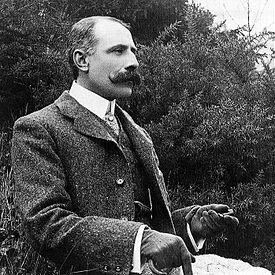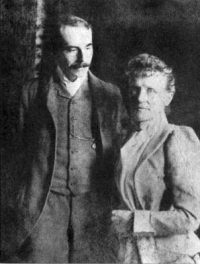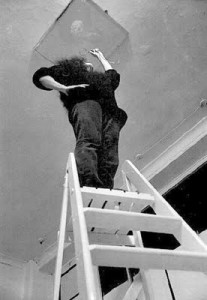Next week, we present a very special apoplectic.me. This would be a great time to sign up for alerts on the right-hand side of the page — or even better, more whimsical and personal extra content in the Tiny Letter distribution.

1. Caroline Alice Elgar
If you like poetry, or this post picqued your interest in poesy, the website of the Scottish Poetry Library is a great resource for readers and writers. Each week, their @ByLeavesWeLive twitter feed points me to their blog sharing poetry-related items coming up on TV and Radio. Last week, the SPL directed me to a repeat of the last episode of Ruth Bedel’s 2007 series about Elgar’s storied variations, The Enigma I Will Not Explain.

I make no apologies for my love of Elgar. Notwithstanding his post-1960 rehabilitation, there remains a temptation to dismiss him an immodishly Edwardian vulgarian. But his contemporaries lauded him as a modernist, and while Pomp And Circumstance may not be my cup of Harney & Sons, the pathos and dark streaks of the Cello Concerto and parts of the Enigma Variations always rouse great emotion in me. So it was very interesting to learn about the story of Variation XIV (“E.D.U.“)
After various movements painting musical portraits of his friends, the last variation is a self-portrait. “Edu” was Alice Elgar’s pet name for her husband, and the variation is a picture of a man who makes up one half of a vital organism. As Elgar wrote, the first variation, C.A.E., is a “reference to one whose life was a romantic and delicate inspiration” — a woman who, as Padel relates, provided Edward “with encouragement and rescued her theme from his subconscious as he improvised at the piano.”

In The Enigma I Will Not Explain, the conductor Mark Elder relates the story of Edward, the son of a piano-tuning shopkeeper, a self-taught violinist and composer and a struggling music teacher, and Caroline Alice, the daughter of a senior British army officer:
He married above himself…. She was a rock for him. He needed her to support him, to give him the courage to keep on working and believing people wanted to hear his music… [even though] he felt the music-loving public was quite small in responding to what his music had to say.
Elgar’s biographer, Jerrold Northrop Moore, suggests that the “enigma” underpinning the variations is not a hidden melody (such as Auld Lang Syne), a biblical reference, or the value of pi, but the enigma of Elgar’s own creativity: “where creative things come from.” Ruth Bedel, a poet herself, notes that Elgar finds new technical answers to the riddle of how to round out his first major orchestral work in the final Enigma variation (the last step on his road to being able to write a concerto), and that the final ‘G’ on which the piece ends, the note of the open bottom string of a violin, is a “most sheerly, joyously glad sound.” As Elgar wrote of his Dream Of Gerontius:
I have written it out, my insidest insides.
Alice, of course, was be part of this alchemic process. But in another week (just like any other) in which sexism has reared its ugly hydra head in the media, I’m reluctant to leave you with a picture of the maternal Edwardian wife dutifully supporting her brilliant husband, lovely as it may be. So let’s redress the balance.
2. Yoko Ono
Oh Yoko! When she’s not Elgar’s wife, pushed into the shade of genius, she’s Elgar, the charlatan. This week, apoplectic.me’s house journal published a really interesting piece by Jonathan Jones on Yoko’s current retrospective in Bilbao (Yoko Ono show at Guggenheim shines light on pioneering conceptual artist). Even in the supposed bible of political correctness, the shit came floating to the top of the comments page, buoyed by sexist undercurrents. At least the response to philistinism was suitably dismissive.
Commentator 1: Can I do this at work when my boss p**ses me off and call it art?
Commentator 2: Yes you can, if you present it as art. How anyone responds to that is another matter. We worked all this out at the turn of the twentieth century. Do keep up.
Why Guardianistas would choose to throw shade at a woman who uses her fame and fortune to support the arts, peace movements, disaster relief, and AIDS and autism outreach is quite beyond me. I guess Ono’s avant-gardeism and off-beat sense of humour turn a lot of people off. These are threatening things. Particularly in a woman. But like Saint John, any time I’ve seen it shorn of filters, I’ve found Ono’s presentation to the outside world quite appealing.

Lennon went to see one of Ono’s first presentations in London, a ladder climbing up to a dangling magnifying glass and a tiny word: “yes”. So began, as Jonathan Jones writes, “one of the great love stories of modern times.” A story so large in intensity that it threatens to overshadow an artistic career that the critic believes predicts, decades early, the work of Douglas Gordon, Damien Hirst, Martin Creed and Rachel Whiteread. Ono’s “peace-mongering” of the sixties and seventies now has a place within serious thought such that Mrs Stroke Bloke and I recently attended a talk by Richard Norman (Emeritus Professor of Moral Philosophy at Kent University) that presented pacifism as a logical conclusion of humanism.

So, I’m taking a leaf by which to live out of Yoko’s book….
A dream you dream alone is only a dream. A dream you dream together is reality.
Not just for Alice and Edu or Yoko and John or even Mrs Stroke Bloke and Stroke Bloke. For all of us. Let’s dream together. You and me and you and you and you and you and you and YOU and…




